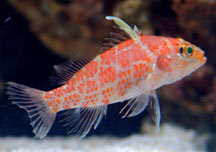Keeping the Jewels of the Reef:
The Anthias of the Genus Pseudanthias - Part 5
By Scott W. Michael
For example, the only member of the genus Nemanthias, the
Threadfin Anthias (Nemanthias carberryi), shows-up in the trade on occasion. It is a resident of the Indian Ocean and while it can be successfully kept in the home aquarium, it tends to be too challenging for the neophyte anthias-keepers. There are also several species in the genus Luzonichthys (commonly known as the slender anthias) that appear in the fish trade. They tend to be fairly durable aquarium inhabitants and their husbandry requirements are similar to that of the Pseudanthias spp.. The males of the Sailfin Anthias (Rabaulichthys spp.) have a very large dorsal fin that is erected when they display toward rivals or potential mates. They do fairly well in reef aquariums if they are fed frequently and not housed with overly-bellicose tankmates.
There are several deepwater anthias that may be represented in the aquarium trade. When these species are available, they command a hefty price because there is much work and danger associated with collecting fish at the depths at which they occur (i.e., typically deeper than 200 feet of water). The lovely Blotchy Deep Anthias (Holanthias borbonius) is one such member of the deepwater Anthinne guild. It has become more readily available to hobbyists of late. It is a hardy aquarium species, but be aware that while juveniles are usually quite congenial, adults will quarrel with one another. While not limited in distribution to deepwater, the Cherry Blossom Basslet (Sacura margaritacea) is limited in its range to southern Japan and Korea. This fish lives at a wide range of water temperatures (from 55 to 80 degrees Fahrenheit), but does best when housed at 78 degrees Fahrenheit or less.
Finally, there is the genus Plectranthias (commonly referred to as
perchlets). The members of this unusual genus look more like hawkfishes than their anthias kin. They spend most of their time resting on their large pectoral fins. They are very small fishes that typically lurk under ledges, among coral rubble, or in reef crevices. The only species that regularly enters the marine fish trade is the Unarmed Perchlet (Plectranthias inermis). While the perchlets are truly the "black sheep" of the subfamily, they make wonderful additions to the reef aquarium (including the nano-reef).
 Scott Michael
Scott MichaelScott W. Michael is an internationally-recognized writer, underwater photographer, and marine biology researcher specializing in reef fishes, and was the Banquet Speaker at our 2007 and 2008 Coral Conference and Frag Swap. He is a regular contributor to Aquarium Fish Magazine, Freshwater and Marine Aquarium Magazine, SeaScope, and is the author of Reef Fishes Vol 1, Vol 2, and Vol 3, Vol 4, and Vol 5., A Pocket Expert Guide Marine Fishes, A Pocket Expert Guide to Reef Aquarium Fishes, 101 Best Saltwater Fishes: How to Choose and Keep Hardy, Brilliant, Fascinating Species That Will Thrive in Your Home Aquarium, Reef Sharks & Rays of the World, and Aquarium Sharks & Rays. Having studied marine biology at the University of Nebraska, Scott has served as a scientific consultant for National Geographic Explorer, the Discovery Channel, and French educational television. |
|||||||||||||||||||||||||||||||||||
|
|
|||||||||||||||||||||||||||||||||||





